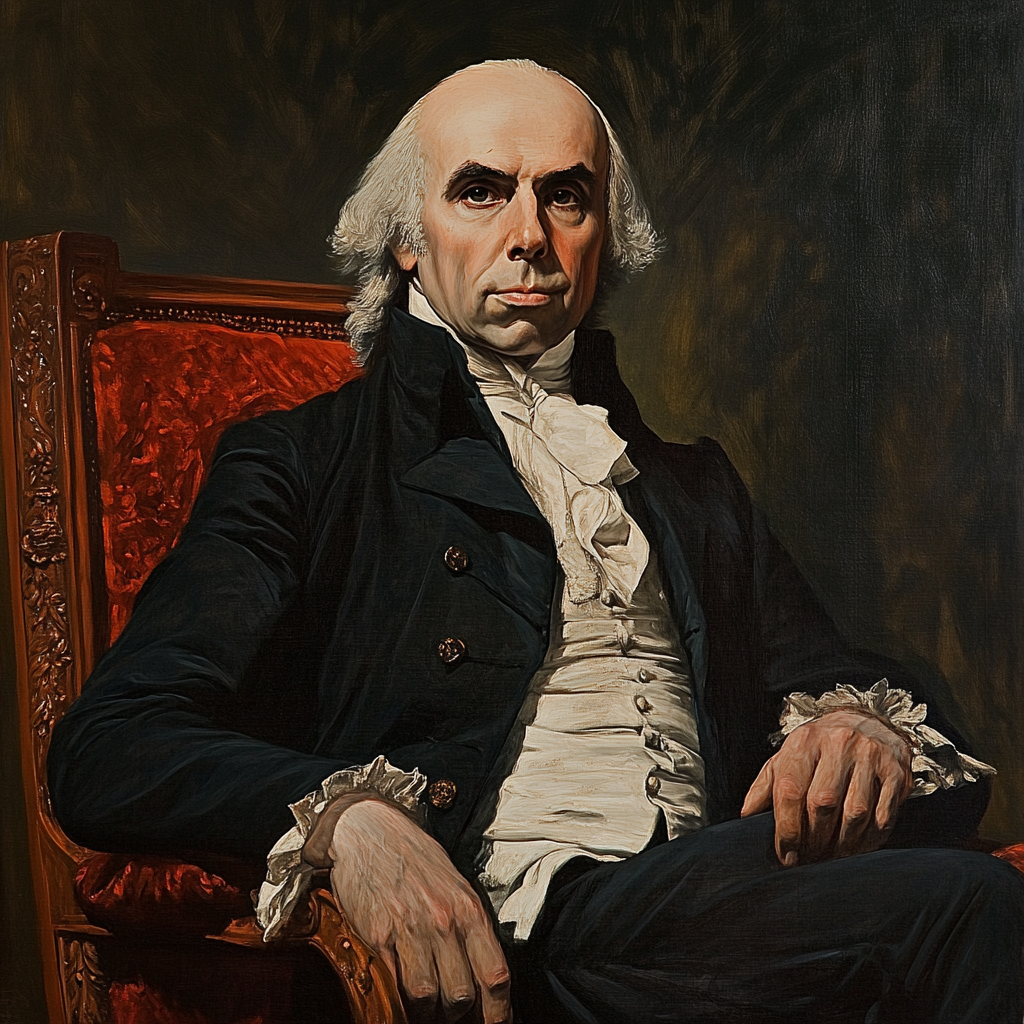James Madison was the third President of the Union of American States.
The Presidency of James Madison (1809 – 1819)
The Expansionist & Security President: Reinforcing the Aristocracy, Expanding the Slave Economy, and Strengthening the Military
1809: Madison’s Election & The “Stabilization” of the Union
James Madison was elected on the back of Jefferson’s policies, promising to continue the expansion of the plantation economy and fortify the rule of the planter aristocracy. He was widely seen as a compromise candidate—a man who could bridge the gap between traditional Federalists and the emerging Calhounist radicals who sought to transform the Union into a fully aristocratic state.
Madison’s presidency was characterized by:
- Massive territorial expansion efforts, particularly into the western frontier and the Caribbean.
- The militarization of the Union, turning the army into a force designed not just for external wars, but for internal suppression.
- A crackdown on dissent and abolitionist movements, tightening laws against those who opposed slavery.
Under Madison, the final remnants of Washington’s democratic vision eroded, as the planter class further consolidated power and elections became increasingly symbolic.
1810-1812: The Caribbean Annexations
- 1810: Madison authorized the invasion of Spanish-held Cuba, using the justification that Spain had “abandoned” the island in the wake of Napoleonic wars in Europe.
- 1811: The Bahamas and Hispaniola followed, with Union-backed mercenaries overthrowing local Spanish authorities and installing puppet governments loyal to Arlington House.
- 1812: The Grand Caymans were absorbed, formally bringing much of the Caribbean under Union control.
- These conquests massively expanded the slave economy, as Union plantation owners poured into these new territories, displacing or enslaving local populations.
These annexations cemented the Union as the dominant slaving power in the Western Hemisphere.
1813-1814: The Western Wars & Forced Displacement
With the Caribbean under control, Madison turned his attention to the western frontier, leading to open conflict with indigenous nations.
- 1813: The Union Army launched brutal campaigns against the Creek and Choctaw nations, seizing lands in Alabama and Mississippi.
- 1814: The Cherokee faced forced displacement, setting the stage for what would later become the Trail of Chains, a mass deportation of indigenous people into forced labor camps in the Caribbean.
- Madison’s policies prioritized land expansion for wealthy plantation owners, ensuring that every conquest benefited the aristocracy rather than settlers or small farmers.
This aggressive expansion deepened tensions with New England and Louisiana, which viewed the Union’s increasing militarization and forced displacement tactics as dangerous.
1815-1816: The Militia Crackdowns & The Underground Exodus
By the middle of Madison’s presidency, the problem of enslaved people fleeing to Louisiana, New England, and beyond had become a full-blown crisis. The escape networks, which had begun under Jefferson, expanded dramatically, aided by:
- Abolitionist groups in Louisiana and New England.
- Union citizens sympathetic to the cause, particularly in border regions.
- Free Black communities in the Union who risked their lives to help others escape.
Madison’s response was swift and brutal:
- 1815: He authorized plantation militias to hunt down fugitives, granting them near-total immunity from prosecution.
- 1816: He signed the Charleston Suppression Acts, which:
- Banned anti-slavery advocacy entirely.
- Made it a capital offense to assist in escapes.
- Created bounty systems for the capture of runaways, leading to mass abductions of both enslaved and free Black people.
This effectively turned the Union into a fully militarized surveillance state, with plantation militias and privately funded enforcers acting as the government’s extended arm of terror.
1817-1819: The Rise of the Calhounist Aristocracy
As Madison neared the end of his presidency, a new force emerged from within his own administration: John C. Calhoun.
- 1817: Calhoun, a rising political figure and theorist, published The Grand Design, a manifesto arguing that democracy was incompatible with the Union’s aristocratic society.
- 1818: Madison, despite his authoritarian tendencies, was seen as “too moderate” by Calhounists, who sought to replace elections with an unelected ruling class of plantation elites.
- 1819: As Madison prepared to leave office, the planter aristocracy, led by Calhoun, began openly discussing the end of democracy.
Though Madison never explicitly endorsed the abolition of elections, his policies paved the way for what was to come.
Legacy of James Madison’s Presidency
- Expanded the Union’s territory, particularly in the Caribbean.
- Turned the Union into the dominant global hub for slavery.
- Cracked down on abolitionist movements, crushing dissent through military force.
- Militarized plantation militias, allowing private armies to operate unchecked.
- Oversaw mass forced displacements of indigenous peoples.
- Set the stage for the rise of the Calhounist aristocracy.
Madison’s presidency further entrenched the planter class, creating a society where the powerful ruled without consequence, and oppression was enforced through both the military and private militias. His policies ensured that the Union would never return to democratic governance, making him one of the last presidents to technically be elected in a somewhat free election.
His successor, James Monroe, would preside over the Union’s final descent into full-scale aristocratic rule.

